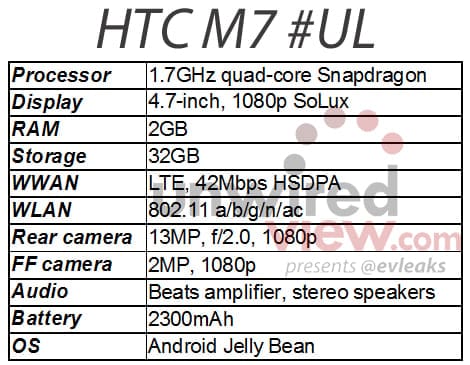The declining profits and the market share that is being stolen from HTC has surely made the Taiwanese manufacturer step up its game, the first indication of which was the HTC Droid DNA for Verizon, which became the world’s first smartphone with a 1080p Full HD display.
However, we then learned that HTC was also working on a device codenamed the M7, which would sport a similar configuration to the Droid DNA, including the 1080p display, but the entire specs list of the M7 that has now leaked out indicates otherwise.
The HTC M7, most importantly, will apparently carry a screen only 4.7-inches in size, making for an even higher pixel density of 468ppi compared to the 440-441ppi of every other 1080p smartphone. People have been thinking that 5-inch may be the only size good enough for 1080p displays, but it seems HTC is not adhering to that philosophy. The display is said to be of the SoLux type, which reportedly provides better viewing angles, outdoor visibility, and color accuracy than the Super LCD2 display on the One X.
The rear camera will see a bump to a 13 megapixel unit and an f/2.2 lens, said to be capable of increased image quality and improved features such as super slow-mo and video HDR, courtesy of the new image sensor, called Cinesensor. 1080p video recording will be possible on both the rear and the 2 megapixel front-facing camera. When it comes to sound, the M7 will sport stereo speakers with the usual Beats Audio enhancements, as well as a feature to increase call clarity called Clear Words.
Powering the HTC M7 will be a second-generation quad-core Snapdragon processor clocked at 1.7GHz, coupled with 2GB of RAM for keeping up with Android’s demands when it comes to heavy multitasking. The OS running on top will be Android (4.2 most likely) Jelly Bean with HTC’s new Sense 5 UI. A 2300 mAh battery will be responsible for keeping the M7 running with all that high-end hardware, making it the highest battery capacity of any HTC smartphone.
There will be 32GB of internal storage, and an LTE chip for fast connectivity, which is a no-brainer if HTC intends to make waves with the M7 in the US. There will also be support for the next-generation Wi-Fi standard, 802.11ac, whose theoretical throughput is three times that of 802.11n Wi-Fi networks.
With so many enhancements and features packed into a single device, some of which will be industry firsts, HTC may have a winner on their hands when they (supposedly) show off the M7 at the Mobile World Congress next year. The HTC M7 is also rumored to be the first HTC device in a long time to be available on all four major carriers in the US.
The HTC M7 sure has us excited, so we’ll be on the lookout for any more info on the device. Naturally, we’ll be letting you know about any developments in the future.
Via: Unwired View













Discussion